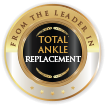


Ankle arthritis can force you to step away from doing the activities you love, the activities that often define you.
Find out about treatment options, watch patient success stories, and learn about Stryker’s Total Ankle Replacement procedure that can be customized to your unique ankle anatomy to relieve pain and increase mobility — so you can return to doing the things that make life fun. That make you happy. That make you, you.
Ankle arthritis occurs when the protective cartilage between bones gradually wears down, causing bones to rub together. This bone-on-bone contact causes pain and makes it more difficult to move. Ankle arthritis can range from less severe to more severe. Total Ankle Replacement is a treatment for severe ankle arthritis.
Symptoms of ankle arthritis
Main causes of ankle arthritis
Non-surgical options
Used for less severe arthritis
Surgical options
For less severe to moderately severe arthritis
For severe arthritis
See comparison chart: Replace or fuse?
*Based on survey conducted by PearlDiver Technologies, Inc. in April, 2018.
Total ankle replacement is for severe ankle arthritis. In ankle replacement, the physician replaces damaged cartilage with an implant that bends and flexes easily, similar to a healthy ankle. Ankle replacement relieves ankle pain and increases mobility, allowing you to get back to activities you love. And it can take half the recovery time of the traditional procedure, ankle fusion. See the comparison chart below.
Procedure customized to your ankle anatomy
Only Stryker Total Ankle Replacement procedures feature a personalized preoperative navigation system option. Using a CT scan of your ankle in advance of your surgery, Stryker can create a plan for sizing and aligning the implant to your unique anatomy, for the most natural fit possible.
Before Total Ankle Replacement, most patients would get an ankle fusion to help relieve end-stage ankle arthritis pain. While ankle fusion is still an effective option for relieving ankle arthritis pain, it prevents motion and many studies1-5 have shown benefits of Total Ankle Replacement over ankle fusion.


References:
 PearlDiver Technologies, Inc. April, 2017
PearlDiver Technologies, Inc. April, 2017
Important Safety Information is available here.
Individual results and activity levels after surgery vary and depend on many factors including age, weight and prior activity level. There are risks and recovery times associated with surgery and there are certain individuals who should not undergo surgery. Only a physician can tell you if this product and associated procedure are right for you and your unique circumstances. Please consult with a physician for complete information regarding benefits, risks, anticipated implant duration and possible outcomes.